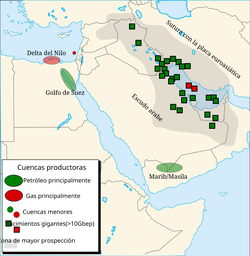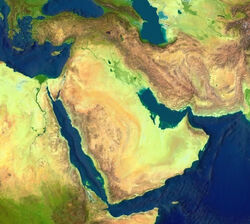
Map of North and South Yemen prior to unification in 1990.
Background[]
Following the collapse of the Ottoman Empire in 1918 after the Great War, northern Yemen became an independent state as the Mutawakkilite Kingdom of Yemen. On 27 September 1962, revolutionaries inspired by the Arab nationalist ideology of United Arab Republic (Egyptian) President Gamal Abdel Nasser deposed the newly crowned King Muhammad al-Badr, took control of Sana'a, and established the Yemen Arab Republic (YAR). This coup d'état marked the beginning of the North Yemen Civil War that pitted YAR troops, assisted by the United Arab Republic (Egypt), against Badr's royalist forces, supported by Saudi Arabia and Jordan. Conflict continued periodically until 1967, when Egyptian troops were withdrawn to join the conflict of the Six-Day War. By 1968, following a final royalist siege of Sana'a, most of the opposing leaders reached a reconciliation. Saudi Arabia recognized the Republic in 1970.
In 1963, Aden and much of the Protectorate were joined to form the Federation of South Arabia with the remaining states that declined to join, mainly in Hadhramaut, forming the separate Protectorate of South Arabia. Both of these polities were still tied to Britain with promises of total independence in 1968. Two nationalist groups, the Front for the Liberation of Occupied South Yemen (FLOSY) and the National Liberation Front (NLF), began an armed struggle (Aden Emergency) on 14 October 1963 against British control and, with the temporary closure of the Suez Canal in 1967, the British began to withdraw. One faction, NLF, was invited to the Geneva Talks to sign the independence agreement with the British. Ironically, Britain, who during its occupation of Aden signed several treaties of protection with the local sheikhdoms and emirates of the Federation of South Arabia, excluded them in the talks and thus the agreement stated "...the handover of the territory of South Arabia to the (Yemeni) NLF...". Southern Yemen became independent as the People's Republic of Southern Yemen on 30 November 1967, and the National Liberation Front consolidated its control in the country.
In June 1969, a radical Marxist wing of the NLF gained power and on 1 December 1970, reorganized the country into the People's Democratic Republic of Yemen (PDRY). Subsequently, all political parties were amalgamated into the National Liberation Front, renamed the Yemeni Socialist Party, which became the only legal party. The People's Democratic Republic of Yemen established close ties with the Soviet Union, the People's Republic of China, Cuba, and the Palestinian Liberation Organization. East Germany's consititution of 1968 even served as a kind of blueprint for the PDRY's first constitution. The major communist powers assisted in the building of the PDRY's armed forces. Strong support from Moscow resulted in Soviet naval forces gaining access to naval facilities in South Yemen.
Unlike East and West Germany or North and South Korea, the YAR and its southern neighbor, the People's Democratic Republic of Yemen (PDRY), also known as South Yemen, remained relatively friendly, though relations were often strained.
The border zone that is now between today's Al Jawf and Hadramawat provinces was never fully clarified in the Cold War and was also often claimed by Saudi Arabia. This would finally be settled in the 1990 Yemeni unity treaty.
In 1972 the two nations declared that unification would eventually occur. However, these plans were put on hold in 1979, and war was prevented only by an Arab League intervention. The goal of unity was reaffirmed by the northern and southern heads of state during a summit meeting in Kuwait in March 1979.
The armed conflicts[]
Data[]
| Factor. | North Yemen. | South Yemen. |
|---|---|---|
| Date . | 1972. | 1972. |
| Location . | North Yemen-South Yemen border. | North Yemen-South Yemen border. |
| Cause Beli. | North Yemen-South Yemen border and Communist vs Capitalist rivalry. | North Yemen-South Yemen border and Communist vs Capitalist rivalry. |
| Location . | North Yemen-South Yemen Border. | North Yemen-South Yemen Border. |
| Result. | No territorial changes. | No territorial changes. |
| Belligerents. | North Yemen supported by Saudi Arabia, Jordan, the United States, Republic of China, the United Kingdom and West Germany. | South Yemen and National Democratic Front supported by the Soviet Union, Cuba, East Germany, Czechoslovakia and Libya. |
| Commanders and leaders | Ali Abdullah Saleh. | Abdel Fattah Ismail. |
| Armed strength | Unknown, but probably about the same size. | 24,000. |
| Cost in US$ | N/A. | N/A. |
| WMD\NCB weapons used? | No. | No. |
| POWs | N/A. | N/A. |
| Civilian dead | N/A. | N/A. |
| Civilian wounded | N/A. | N/A. |
| Military dead | Under 10 | Under 10. |
| Military wounded | Under 10. | Under 10. |
| Total dead | N/A. | N/A. |
| Total wounded | N/A. | N/A. |
The 1972 conflict[]
Unlike the early decades of East Germany and West Germany, North Korea and South Korea, or North Vietnam and South Vietnam, North Yemen (YAR) and South Yemen (PDRY) remained relatively friendly, though relations were often strained. Fighting broke out in the October of 1972, and a short-lived, small proxy border conflict was resolved with negotiations, where it was declared unification would eventually occur.
However, when fighting erupted between the North Yemen and the South Yemen in October 1972; North Yemen was supplied by Saudi Arabia and South Yemen by the USSR. Fighting was short-lived and the conflict led to the October 28, 1972 Cairo Agreement, which set forth a plan to unify the two countries.
What the PDRY government failed to tell the YAR government was that it wished to be the dominant power in any unification, and left wing rebels in North Yemen began to receive extensive funding and arms from South Yemen.
The 1979 conflict[]
However, these plans were put on hold in 1979, as the PDRY funded Red rebels in the YAR, and war was only prevented after some brief border skirmishes by an Arab League intervention. The goal of unity was reaffirmed by the northern and southern heads of state during a summit meeting in Kuwait in March 1979.
When fighting broke out again in February and March 1979, in part as a result of the earlier 1972 conflict, with South Yemen allegedly supplying aid to rebels in the north through the National Democratic Front (of South Yemen) and crossing the border. Southern forces made it as far as the city of Taizz before withdrawing. This conflict was also short-lived. The war was only stopped by an Arab League intervention. The goal of unity was reaffirmed by the northern and southern heads of state during a summit meeting in Kuwait in March 1979.
The aftermath[]
Unlike East and West Germany, the two Yemens remained relatively friendly, though relations were often strained. In 1972 it was declared unification would eventually occur, but this later lead to a civil war.
In 1980, PDRY president Abdul Fattah Ismail resigned and went into exile in Moscow, having lost the confidence of his sponsors in the USSR. His successor, Ali Nasir Muhammad, took a less interventionist stance toward both North Yemen and neighbouring Oman.
Also see[]

Oil and gas fields in the Levant, Egypt and the Persian Gulf.

A NASA globe software World Wind satellite image of the Middle East.
- Six-Day War
- Suez Crisis
- Middle East
- Aden Emergency
- Yom Kippur War
- Time line of Iraq
- 1948 Palestine war
- North Yemen Civil War
- Iranian Revolution
- 1970s energy crises
- Minerals and fuel in central Africa
- What women should wear in the Middle East
- Mineral mining, smelting and shipping videos
- Winning a hot war
- Six-Day War
- Suez Crisis
- The Al-Wadiah War (1969)
- Aden Emergency
- Yom Kippur War
- Time line of Iraq
- 1948 Palestine war
- Iranian Revolution
- 1970s energy crises
- Minerals and fuel in central Africa
- What women should wear in the Middle East
- Mineral mining, smelting and shipping videos
- North Yemen Civil War
- Iranian videos page
- Iran-Iraq war
- Palestine vs Israel
- 1970s energy crises
- 1953 Iranian coup d'état
- What women should wear in the Middle East
- Bourj el-Barajneh and it's refugee camp
- Israel invasion of Lebanon in 1982
- Oman, UAE and Yemen Cold War conflicts
Sources[]
- https://en.wikipedia.org/wiki/South_Yemen
- https://en.wikipedia.org/wiki/Yemen_Arab_Republic
- https://www.scribd.com/document/51196986/CIA-Study-on-Yemeni-Unification
- https://books.google.co.uk/books?id=0yUzV-g2X2QC&pg=PA98&dq=%22arab+league%22+yemen+1972&hl=en&ei=KOGMTZC3HaaB0QH-3ry2Cw&sa=X&oi=book_result&ct=result&redir_esc=y#v=onepage&q=%22arab%20league%22%20yemen%201972&f=false
- https://en.wikipedia.org/wiki/Yemeni_unification
- https://www.onwar.com/aced/chrono/c1900s/yr70/fyemennorthsouthwar1972.htm
- http://www.historyguy.com/wars_of_yemen.html
- http://www.wrmea.org/1994-july-august/north-and-south-yemen-lead-up-to-the-break-up.html
- http://www.abc.net.au/news/2015-04-15/yemen-a-century-of-conflict/6381720
- https://en.wikipedia.org/wiki/Modern_history_of_Yemen#Relations_between_the_North_Yemen_and_the_South_Yemen
- http://www.lesclesdumoyenorient.com/IMG/png/yemen_carte_1.png